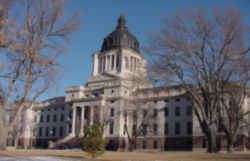

South Dakota History
Historic Facts & Overview of South Dakota History
Take a peek at South Dakota history. Discover an overview of South Dakota's rich history, heritage, historic events, and culture.
A Great Plains state, South Dakota was named for the Dakota division of the Sioux Indians, and is known as the Coyote State. Admitted simultaneously with North Dakota after the Dakota Territory was divided along the 46th parallel, South Dakota is mainly a rural state. Today, just less than 10 percent of its population is American Indian. South Dakota is known for two monumental sculptures carved into the Black Hills--Mount Rushmore, which honors presidents Washington, Jefferson, Lincoln, and Theodore Roosevelt, and the Crazy Horse Monument, still under construction, which honors the Oglala Sioux war chief. The state flower is the pasqueflower, also called the May Day flower; its blooming is one of the first signs of spring in South Dakota
Overview of South Dakota History and Heritage
The State of South Dakota is a part of that vast domain which was acquired by the United States through the celebrated Louisiana Purchase in 1803. President Thomas Jefferson purchased the territory, which includes the present states of Missouri, Kansas, Nebraska, Iowa, Minnesota, North and South Dakota, Montana, Idaho, and a significant portion of modern day Louisiana from France for fifteen million dollars and the assumption of certain claims held by citizens of the United States against France.
Although nine states eventually were organized out of the Louisiana Purchase, during their existence as territories, the boundaries of these divisions were subject to frequent and marked changes, with names appearing and disappearing.
Exploration of this area began in 1743 when Louis-Joseph and François Verendrye came from France in search of a route to the Pacific. South Dakota was originally part of what was called the Louisiana Territory. The US acquired the region as part of the Louisiana Purchase in 1803 and it was explored by Lewis and Clark in 1804-06. Fort Pierre, the first permanent settlement, was established in 1817. In 1831, the first Missouri River steamboat reached the fort. In 1812, the part of South Dakota lying west of the Missouri River became known as the "Mandan Territory,"and the area lying east of the Missouri River became incorporated into the Missouri Territory. The eastern half of South Dakota was included in the Michigan Territory in 1834 and two years later it became part of the Wisconsin Territory. In 1849, after the organization of Wisconsin as a state, the area east of the Missouri River was included in the Minnesota Territory. The portion of South Dakota west of the Missouri River was included in the Nebraska Territory in 1854.
Settlement of South Dakota did not begin in earnest until the arrival of the railroad in 1873 and the discovery of gold in the Black Hills the following year. The admission of Minnesota as a state in 1885 left all the country west of its boundaries along the Big Sioux River to the Missouri River without any organization, legal name or existence. This part was, by common consent, designated by the name of Dakota. Dakota is an Indian name that means "confederated"or "leagued together"and was originally derived from the great associated tribe of Indians, which is known in their own language as Dakotas. In 1861, President James Buchanan signed the Organic Act, creating the Dakota Territory, which included the present states of North and South Dakota, Montana, Wyoming and a small part of Nebraska. By 1868, the Dakota Territory consisted of only what are North and South Dakota today. In 1889, the "Omnibus Bill"or the Enabling Act was adopted, which provided for the dividing of Dakota Territory into the states of North and South Dakota. This enabled the two Dakotas, Montana and Washington to formulate constitutions.
South Dakota's economy in recent years has benefited from an expanding and diversifying industrial base. Agriculture is a cultural and economic mainstay, but it no longer leads the state in employment or share of gross state product. Durable-goods manufacturing and private services have evolved as the drivers of the economy. Tourism is also a booming industry in the state, generating approximately $1.25 billion worth of economic activity each year.
South Dakota is the second largest producer of flaxseed and sunflower seed in the nation. It is the third largest producer of hay and rye.
South Dakota is the nation's second leading producer of gold and the Homestake Mine is the richest in the US Other minerals produced include berylium, bentonite, granite, silver, and uranium.
The Black Hills are the highest mountains east of the Rockies. Mt. Rushmore, in this group, is famous for the likenesses of Washington, Jefferson, Lincoln, and Theodore Roosevelt, which were carved in granite by Gutzon Borglum. A memorial to Crazy Horse is also being carved in granite near Custer.
Other tourist attractions include the Badlands; the World's Only Corn Palace, in Mitchell; and the city of Deadwood, where Wild Bill Hickok was killed in 1876 and where gambling was recently legalized to truly recapture the city's Old West flavor
Today, South Dakota is located in the heartland of the United States. It is a rectangular area approximately 370 miles by 210 miles. Its 77,047 square
miles make it the 16th largest in size among the fifty states. South Dakota has a population of around 820,000.






